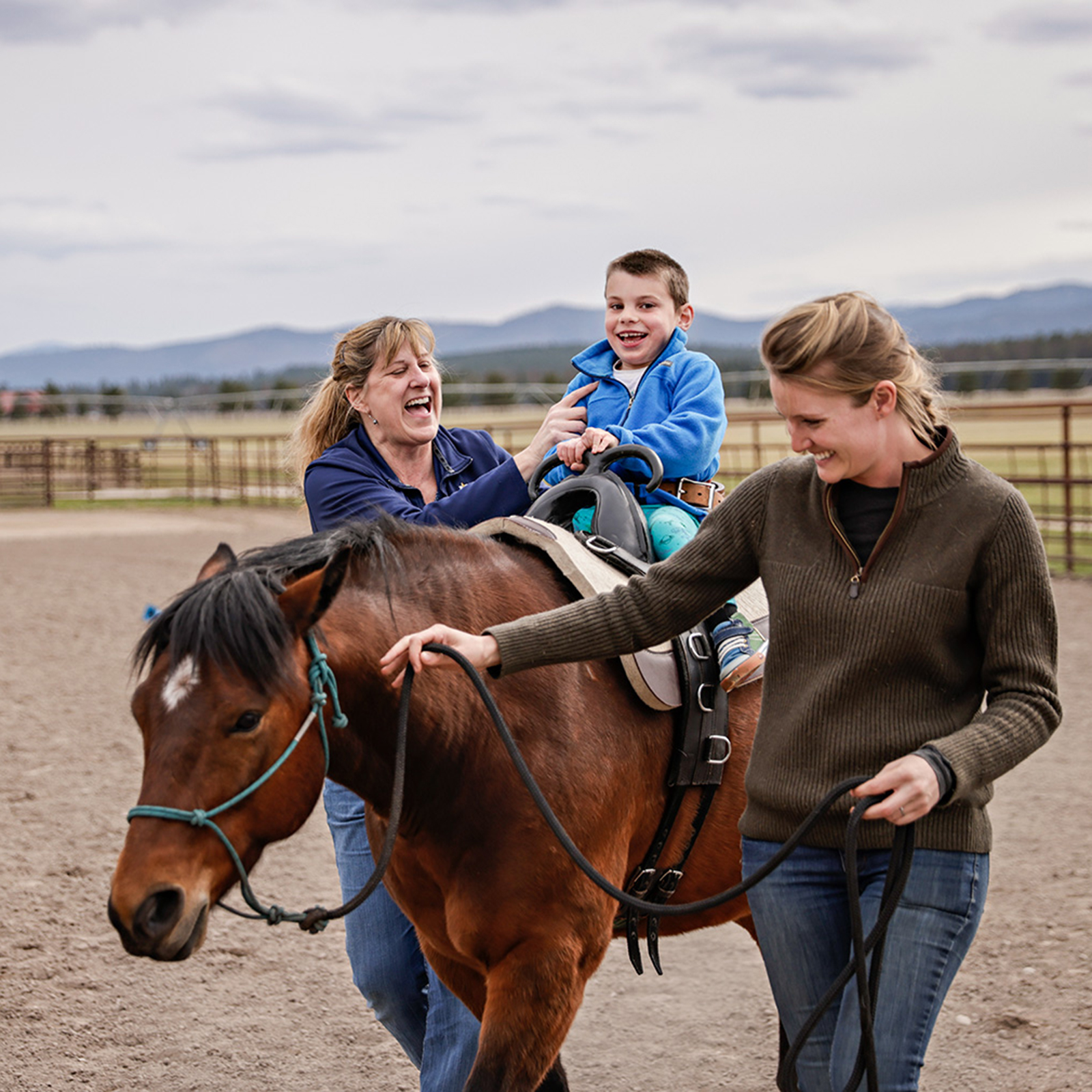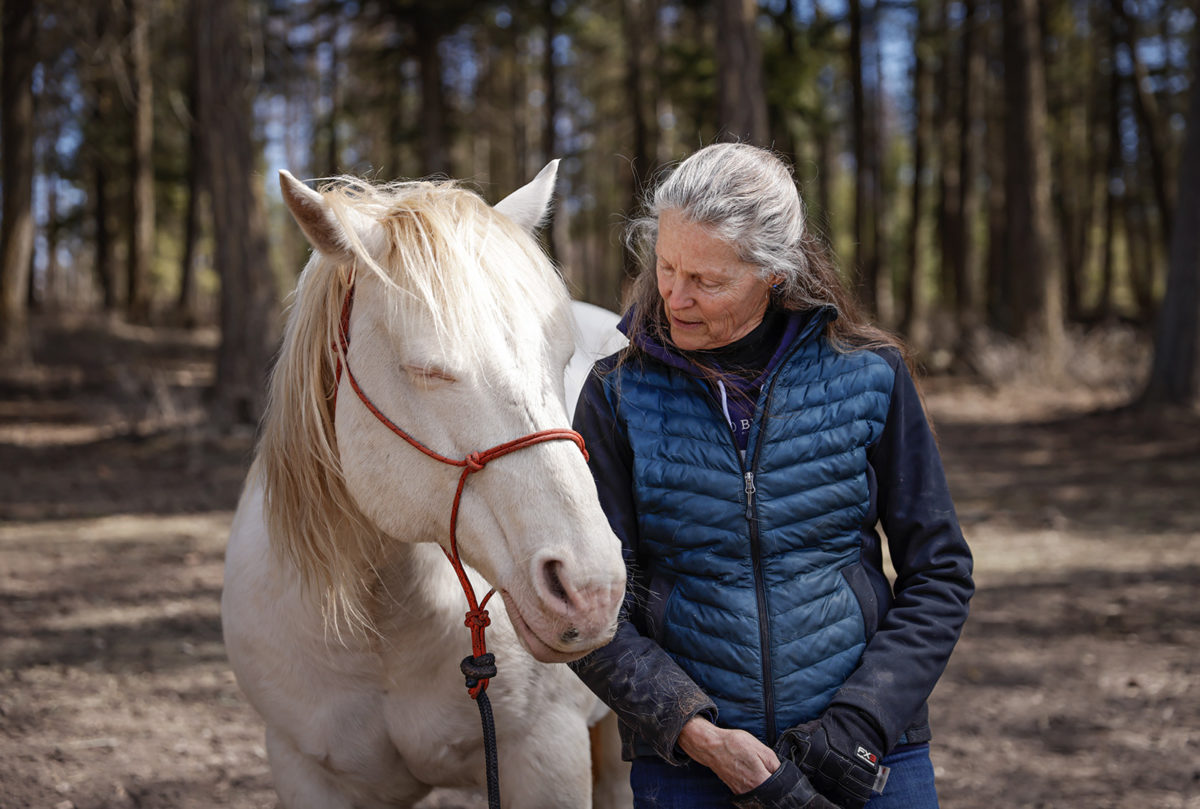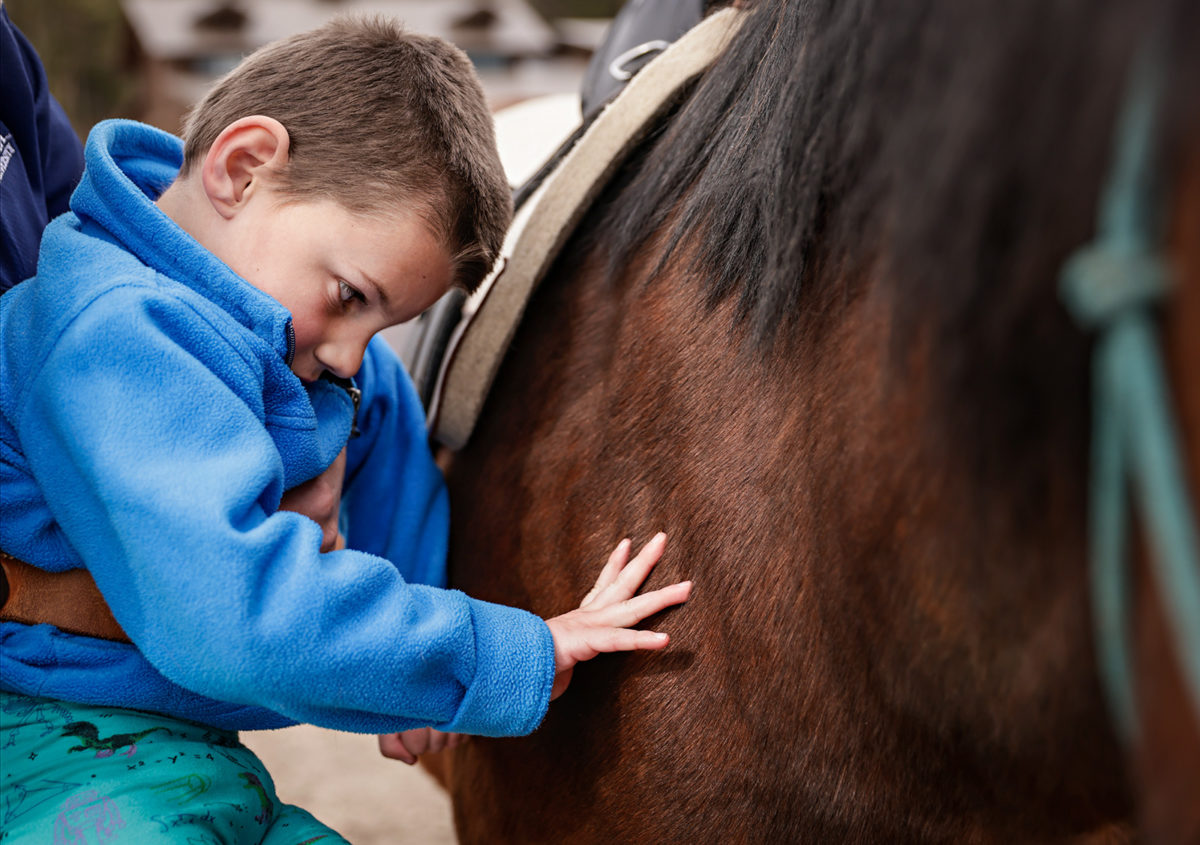
To hear Kat Licence tell it, a horse is at its basic level operating with the instincts of a “flighty prey animal,” or to put it in more technical terms, “a 1,200-pound chicken.”
Licence is the executive director of the Two Bear Therapeutic Riding Center, which sits on 600 acres between Whitefish and Kalispell, where trails wind through forested pastures that open up into broad, green fields and a boundless horizon that seems to mirror the vast possibilities of what a horse can achieve for a human.
And while it might be tempting to dwell on the possibilities of a horse-sized chicken, the point of the analogy Licence offers is to emphasize that a horse knows it can be another animal’s prey, and if it thinks it sees a predator or some other kind of threat, it’s not going to stand still. Which is to say that a horse has an existential stake in getting a read on you and your intentions, and according to Licence, it can do exactly that, from up to a mile away. What that means is that the interaction between a human and a horse is a kind of agreement.
“With horses, they seek peace. Always. That is what they want. They want it to be quiet. They want to be safe, and they want to have food in front of them,” Licence said. “And so, as people, if you’re dealing with trauma, or you know, some sort of struggle, self-hatred, depression, anything like that, you can’t hide an emotion like that from an animal that is so hypersensitive on protecting themselves.”
That effort to approach a horse with good, clear intentions is integral to some of the work being done at the Two Bear Therapeutic Riding Center. While the center does offer summer camps and field trips, the crux of its purpose is to function as a place where children and adults can work on themselves by working on a horse. That can come in the form of adaptive horsemanship lessons, equine-assisted psychotherapy, or pediatric physical therapy.

The riding center started about five years ago but has kept a relatively low profile in the years since. That’s not by accident. Licence said that they’ve reached a level of confidence with the program such that they now feel comfortable promoting themselves more broadly. With a good, strong foundation, she said it now feels like the riding center is not only sustainable but capable of growing, which is where horses come back into the conversation, as they frequently do at the riding center.
“The biggest thing that you see in therapeutic riding centers is burnout,” Licence said.
The burnout Licence is referring to is among the horses at a therapeutic riding center. All of that sensitivity and perceptiveness and patience that the right type of horse can bring to the table can also contribute to the animal growing exhausted by the constant task of evaluating the nature of the people both atop it and around it during therapy sessions.
There are nine horses at the riding center that are involved in lessons and therapeutic work, and before each session, the staff there try to select horses based on how the horse seems to be doing that day along with how its physical and temperamental traits mesh with what their rider is trying to accomplish on any given day. That might involve a character like YoGo, a horse with pale blue eyes and a light-colored coat whose laidback demeanor has earned him the unofficial title of hippie horse of the ranch. Or it could be YoGo’s son Pumpkin, a quarterhorse-Arab cross with coloring that in the horse world is called a tri-color buckskin paint. White and tan patches along his frame are offset by a black tail and mane.
Just a couple of years ago, Whitefish philanthropist Michael Goguen donated the use of his Two Bear River Ranch to the center. The use of the ranch means among other things that the program has access to a heated indoor arena and a 150-by-200-foot outdoor arena. A converted barn with carpeted flooring acts as an additional space for activities that don’t directly involve horses but might still be necessary to help a client meet their goals.
Working on something like an exercise ball isn’t something that staff at the center scoff at, but they’re also well aware of what a horse can do by comparison. This is where the word “input” starts to come into the conversation.
Sally Conrad is a certified riding instructor through the Professional Association of Therapeutic Horsemanship International. She’s also Licence’s mother and a member of the riding center staff. As Conrad discusses the concept of input, she’s watching a young, nonverbal girl with cerebral palsy sit atop Pumpkin. The girl, 9-year-old Lilli Grace Portanova, is being slowly eased onto the horse as a staff member holds her in place. They’re getting ready to start moving around the indoor arena and the girl’s eyes are closed at first but slowly open as she lies down across the back of the horse as if on a bed.

“Sometimes in a session like this every step is an input,” Conrad said of the horse’s movement. “They’ll get 4,000 repetitions of that. If you’re on an exercise ball—nothing wrong with an exercise ball in a PT’s office—but you’re not going to get anywhere near the same.”
Lilli Grace’s mother, Lynn Marie Portanova, said that her daughter’s condition means that Lilli Grace lives with a lot of pain, and a couple of years ago her health declined inexplicably. There have been gains since then, and Portanova credits the riding center with helping improve her daughter’s executive function, strength, speech, and even appetite. She said that in difficult moments the mention of riding can produce a smile on the girl’s face, and that car rides to the center bring out giggles and laughter. Even without the physical improvements Portanova attributes to her daughter’s sessions at the riding center, she said it would be worth it because of the joy it gives Lilli Grace. “It increases her quality of life,” Portanova said.
On another day at the center Leslie Hayden, a PATH registered physical therapist certified by the American Hippotherapy Certification Board, explained the concept of inputs in even more detail.
“In 30 minutes of a child being on a horse walking, they get about 3,000 neural inputs. So every time the horse steps the child’s getting a percussive force. And so it just wakes up the nervous system so much more,” Hayden said. “A horse has exactly the same pelvic motion that we do when we walk. And a lot of my kids cannot walk. So when they’re on the horse and they feel this, they start to feel, ‘Okay, what’s it like to move this way.’
“It makes a tremendous difference,” Hayden added.
The little kiddo Hayden is referring to is 7-year-old Miles Eklund from Somers. He was born with a condition that has left him with strong cognition but difficulties communicating verbally. The same issue has left Miles with very limited ability to control his body, which means he often has to be physically supported in order to remain upright.
He’s been working with Hayden for more than five years. During his first encounter with a horse at the center, he was terrified. His mother Carrie Eklund recalled how he screamed almost the entire time. His core strength was so limited that he had to have two people help stabilize him. But a lot has changed in the years since.
Now, Miles is all smiles when he’s on top of a horse, and the two people supporting him have been whittled down to a hand or two as he grips a specialized pommel and rides a pony named Brady around the arena.

Pausing at times to consider her words, Eklund talked about what it’s like to be a parent of a child with disabilities. It can be a lonely feeling at times, she said. The workforce shortages that have hit the healthcare industry aren’t affecting just hospitals. Eklund’s family is eligible for a waiver through the state that would reduce the costs of home care services, but there’s no one to hire, even when they offered more money on top of what the waiver covers. Because of Miles’ needs, it falls on different members of the family to work together to care for him. She’s an engineer by trade, while her husband is a farmer.
Eklund said that after understanding the reality of what Miles’ life would look like for him and her family, there was a period of grieving the child she expected to have. Life plans suddenly had to be changed in major ways. “The same day we got his diagnosis we actually signed a lease out in Geraldine, Montana, where the family farm is,” she said.
They didn’t know at first that anything was wrong with Miles, but she said she wonders sometimes when she might have known something, recalling that at six months he wasn’t using his hands. She said that doctors eventually determined Miles was born with a rare brain condition resulting in symptoms comparable to severe cerebral palsy and epilepsy. It’s not a chemical imbalance, but the actual physical makeup of his brain that causes the issues. Having gone through all the shakeups and doubts and mourning, Eklund said she’s reached a point now where the idea of caring for Miles throughout his life feels like a privilege.
“It’s not a tragedy. It’s not something to be pitied,” she said. “I actually am sad for myself before I knew the richness of that really caring-focused approach to life. It’s a different pace. You can’t be trying to keep up with people. You have to be ready to fight and advocate all the time. But that doesn’t have to define you. So you find places like this that are just wonderful.”
At the end of Miles’ work that day with Hayden and Brady comes a small but meaningful reward for the boy. He has a little more control of his right hand, so Hayden picks up Miles in her arms and brings him around so that his right hand can reach Brady’s mane and neck just above the shoulder. The session is over, but not before Miles gets to pet Brady. He reaches out slowly, his hand going up and down. It’s what Hayden calls his way of saying thank you. Brady stands there quietly. Beneath his brown eyes those flighty prey instincts seem distant, as if to say that he sees Miles for who he is, and knows his intentions are good.